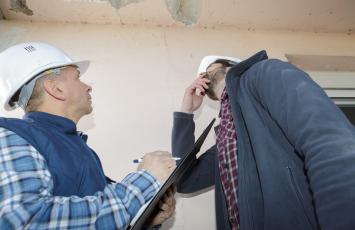BLOG: A CASE FOR STRENGTHENING DOD OVERSIGHT OF MILITARY PRIVATIZED HOUSING
The U.S. Department of Defense (DOD) privatized military housing starting in 1996, with the passage of the Military Housing Privatization Initiative (MHPI) under the National Defense Authorization Act. The MHPI allowed private companies to build, renovate, and manage military housing on DOD installations. The goal of the program was to improve the quality of housing for military families and to free up DOD resources to focus on other priorities.
Regular facility assessments are vital for the United States military to ensure operational readiness, safety, and efficiency. Decision making based on accurate data allows the military to adapt to evolving challenges, enables personnel to better perform their duties, reduces residents’ confusion and frustration, and strengthens the Military Privatized Housing Initiative.
As of 2023, private companies own and operate about 99% of homes at U.S. military installations. The MHPI has had a mixed impact on the conditions in military family housing. In the early years of the program, private companies invested billions of dollars in new construction and renovations, which improved the overall quality of housing for military families. Additionally, private companies are generally more responsive to maintenance requests than the government was, which helped to reduce the number of housing-related complaints.
However, there have also been some significant problems. In recent years, there have been numerous reports of military families living in substandard housing, with myriad health and safety concerns. These problems have led to concerns about the health and safety of military families, as well as their morale and readiness.
In recent years, the DOD has launched a number of reforms aimed at addressing the problems with privatized military housing. Among these reforms are:
- Increasing DOD's oversight of for-profit military housing companies.
- Strengthening the Tenant Bill of Rights for Privatized Housing.
- Providing more financial assistance to help families find affordable housing off-base.
- Making more money available for the Emergency Housing Allowance (EHA).
The DOD has also set a goal of having all privatized military housing meet its standards by 2025. However, it remains to be seen whether the reforms will be enough to fully address the problems with privatized military housing.
In order to address the problems with privatized military housing, the DOD will need to do the following:
- Continue to increase its oversight of private housing companies. DOD should introduce a program of regular health and safety inspections, including third-party assessments, to identify and address potential hazards. This program should include specific requirements for remediation and ensure proper communication channels for reporting and addressing concerns.
- Make sure that private companies are held accountable for meeting DOD standards. DOD could require private companies to adhere to strict maintenance and repair schedules and establish penalties for non-compliance. Regular inspections and reporting mechanisms can also help ensure accountability.
Improve transparency and accountability. Residents have faced difficulties in resolving issues and obtaining information about their rights and responsibilities. To improve transparency, the DOD can enhance support of clear communication protocols, easily accessible grievance mechanisms, and regular dissemination of information regarding rights and resources available
- to military families. This can help ensure that residents are well-informed and able to address concerns effectively.
- Work with Congress to pass legislation that would give the DOD more power to regulate privatized military housing. While DOD can execute an effective oversight program, Congress must act to provide the funding and directives necessary to underpin such a program. Unfunded mandates rarely return positive results.
- Establish a Culture of Safety in military family housing. DoD policy recognizes the importance of safety in family housing, but supporting requirements are scattered across various DoD policies and regulations. This importance is reinforced through DoD’s Tenant Bill of Rights for Privatized Housing which emphasizes the need for safe housing. The challenge for both government-owned and privatized housing is the lack of a single, comprehensive source that clearly defines the "applicable health and environmental standards" for child safety in family housing.
The privatization of military housing was a well-intentioned effort to improve the quality of life for military families. However, the program has not lived up to its full potential. DOD is taking steps to ensure that all military families have access to safe and affordable housing, but Congress needs to do its part to support the effort.
A Programmatic Approach to Condition Assessments and Inspections in Military Family Housing
Bureau Veritas, together with our industry partners, and on behalf of responsible Army, Air Force, and DOD activities, is performing inspections and condition assessments for military housing at installations around the world. Similar work is being done by others for the Navy. The effort is critical to setting a baseline understanding of the conditions and needs across all housing, but even this is just a snapshot in time that will soon be out of date if it does not become an ongoing program of inspection, assessment, and oversight.
There is precedence for this in the federal government. The BUILDER Sustainment Management System (SMS) is a web-based software application developed by the U.S. Army Corps of Engineers Construction Engineering Research Laboratory (CERL) to help civil engineers, technicians, and managers decide when, where, and how to best maintain building infrastructure. This software supports an ongoing program focused on capital planning for non-housing infrastructure. Although far from a perfect solution, there is a lot of value in standardizing planning data across a massive asset portfolio and renewing those data on a regular schedule to keep the information up to date. A similar, albeit lighter and less expensive, programmatic approach to inspecting military housing should be followed.
A programmatic approach to condition assessment and inspection should include:
- Facility Condition assessments to Identify Maintenance and Upgrades: Regular and reoccurring assessments enable the identification of maintenance and upgrade needs within military facilities. Aging infrastructure, wear and tear, and technological advancements necessitate periodic evaluations to determine the areas that require attention. From repairing structural defects to upgrading equipment and systems, facility assessments provide a comprehensive overview of the maintenance and modernization requirements.
- Facility Condition assessments to help Ensure Safety and Security: Military housing must prioritize the safety and security of personnel and assets. Assessments evaluate various safety aspects, including fire protection systems, emergency response protocols, and compliance with safety regulations.
- Optimizing Resource Allocation and Capital Planning: Facility assessments play a crucial role in optimizing resource allocation within the military. By identifying inefficiencies, redundancies, and areas of improvement, assessments identify where resources should be allocated to maximize operational effectiveness.
- Energy Audits and Resiliency: Making good investments in energy efficiency starts with identifying and prioritizing energy conservation measures in existing housing stock. Energy efficient homes improve the quality of life for military families and lowers their overall cost of living. This is increasingly important in an era of climate change.
Regular facility assessments are vital for the United States military to ensure operational readiness, safety, and efficiency. Decision making based on accurate data allows the military to adapt to evolving challenges, enables personnel to perform their duties better, reduces residents’ confusion and frustration, and strengthens the Military Privatized Housing Initiative.
BV has extensive experience performing a wide range of facility assessments and inspections in every industry and geography across the world. BV is committed to helping organizations meet performance objectives, comply with regulatory requirements, and ensure the safety and integrity of their facilities.


